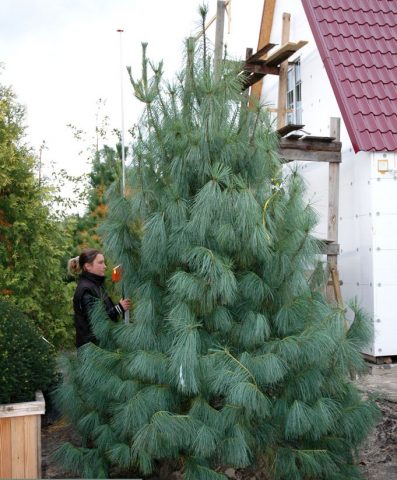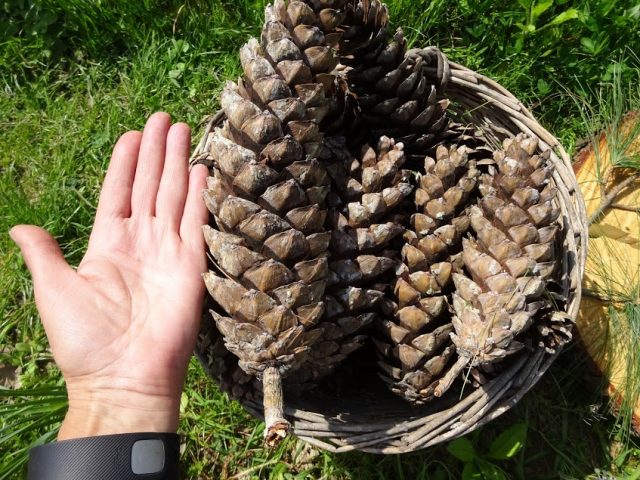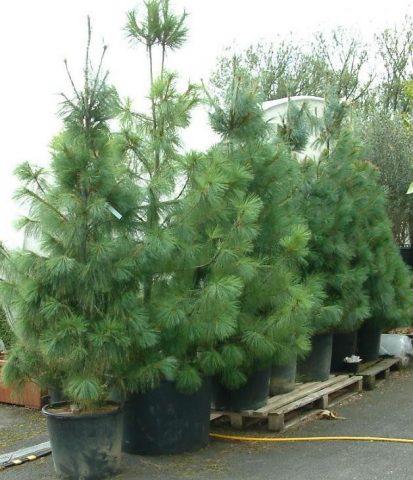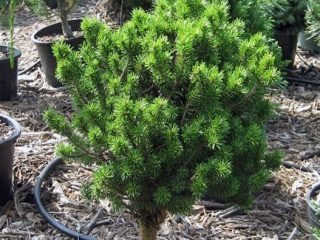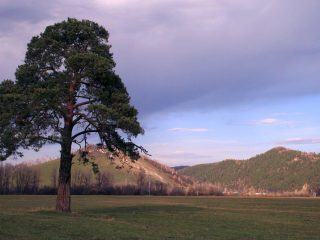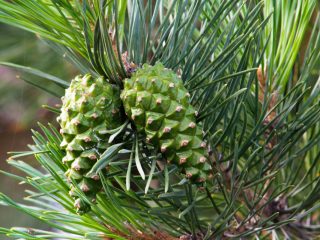Content
The Himalayan pine has several other names - Wallich pine, Griffith pine. This tall coniferous tree is found in the wild in the mountainous Himalayan forests, in eastern Afghanistan and in western China. The Himalayan pine is valued for its decorativeness, therefore it is grown everywhere.
Description of Himalayan pine
The Himalayan pine belongs to a kind of gymnosperms from the Pine genus. This tree grows up to 35-50 m in height. Crohn has a wide pyramidal shape of a loose structure. Branches are long, flexible, horizontal, growing from the ground line. The decorativeness of the culture lies in the long, thin needles. The length of each needle reaches 20 cm, and the thickness is about 1 mm, so the needles are very flexible. The needles are collected in bunches containing 5 needles. Young needles resemble Scots pine needles, and with age, the needles hang down, which gives them a similarity to willow. The shade of the needles can be bluish-green or bluish with a silvery sheen. Each needle grows on a tree for at least 3-4 years.
Cones after ripening become yellowish, their length is from 15 to 32 cm, width is no more than 7 cm. The shape is cylindrical, slightly curved. The seeds are provided with an elongated wing, the total length is about 30–35 mm. Pine blooms at the end of April, the timing is individual and depends on the region of cultivation. Cones ripen in the second year after flowering, around mid-October.
Young specimens are distinguished by dark gray, smooth bark; in older trees, it becomes covered with cracks, changes its color to ashy and in places exfoliates from the trunk. The color of young shoots is yellowish-green with a characteristic sheen, the bark is absent.
The roots of the Himalayan pine are located in the upper layer of the earth, the central core reaches a length of 1.5 m.
The life span of the Himalayan pine in the wild is about three hundred years. Annual growth depends on growing conditions. Under favorable conditions, the pine shows an increase in growth of about 60 cm, the width of the tree increases to 20 cm every year, which is considered a good indicator for coniferous seedlings.
The approximate height of a tree that has grown in the conditions of central Russia is 12 m by the age of 35. In the Crimea, a pine of the same age will grow twice as high, that is, up to 24 m.
The degree of frost resistance in Himalayan pine is high, the culture is able to withstand a temperature drop down to -30 ° C, but branches break under the load of sleet or blizzard.
The Himalayan pine wakes up at the first warming, which can result in damage to shoots from return frosts. If the tree managed to survive, it will not give growth this season, since all forces will be directed to recovery.
Ornamental needles can suffer from bright sunlight during winter and spring. Especially dangerous is the sun reflected from the dazzling white snowdrifts. It leads to burns on the needles.
Himalayan pine in landscape design
The main beauty of the Himalayan pine lies in its long hanging needles.The tree is actively used for landscaping park areas; it can be planted in a flower bed in a single copy or in groups. Coniferous seedlings go well with rocky hills.
The dwarf version of the Himalayan pine, Nana, is popular; it forms a sphere up to 2 m in diameter. The needles of this subspecies are also decorative and hang down with age like a willow, but the needles are much shorter than that of a tall tree. The length of the needles does not exceed 12 cm. Another dwarf spherical specimen is Schwerinii Wiethorst. It was received by German breeders in the process of hybridization of Weymouth and Himalayan pine. The crown of this variety is dense, fluffy, spherical, up to 2.5 m in diameter.
Dwarf species are used for landscaping home gardens, they look good both in single and in group plantings, they are planted in rocky gardens, on slides, in mixborders.
Planting and caring for a Himalayan pine
In order for a seedling to start and be a decoration of the territory for a long time, it is necessary to familiarize yourself with the requirements for its planting and growing.
Seedling and planting plot preparation
Himalayan pine can be grown on the territory of Ukraine, Belarus, as well as in the southern and middle latitudes of Russia.
The choice of location is made according to the following criteria:
- the tree does not like gusts of wind, so it should be located behind a high fence, a wall of a building. The issue of wind protection is especially relevant in the northern regions;
- the place should be well lit, but not with direct sunlight, but with diffused light. The needles can suffer not only in summer, but also during the period from February to March during thaws and return frosts;
- Himalayan pine loves light, well-drained soil without moisture stagnation. Ephedra will not grow in wetlands. Alkaline soils are not suitable for growing pine.
Before removing from the container, the seedling is well watered.
Planting rules for Himalayan pine
The approximate depth of the planting pit is 1 m. The size of the hole is determined by the container in which the seedling was purchased. A hole is dug about 2 times more than an earthen lump on the root system. The distance between adjacent trees should be about 4 m.
A mixture consisting of peat, earth and sand, taken in equal proportions, is poured into the planting pit. A drainage layer (stones, pebbles, broken bricks, gravel, sand) is poured into the bottom of the planting hole. If the soil is clayey, heavy, the drainage layer should be at least 20 cm.
The seedling is placed in a hole along with an earthen lump, and the prepared soil mixture is poured on top.
Watering and feeding
During the first two years, the seedling gets used to the growing conditions, therefore it needs regular watering and feeding. Older pines can grow during drought periods without additional soil moisture, but the trunk circle must be mulched.
Closer to autumn, it is recommended to feed the pine with potassium-phosphorus compounds, and in the spring superphosphate will benefit.
Mulching and loosening
Mulching protects the root system from hypothermia and excessive evaporation of moisture. The mulch layer should be at least 10 cm. Peat, crushed tree bark, wood shavings or sawdust can be used as mulching materials. A layer of mulch prevents the soil from drying out and at the same time improves its composition.
Pruning
When carrying out formative pruning, one should adhere to the rule that the growth should not be completely removed. Shoots are shortened by no more than 30%, cutting off all branches.
After winter, sanitary pruning is carried out. At the same time, broken, frozen and dried branches are removed.
Preparing for winter
Young pine seedlings need shelter for the winter. But it is not recommended to carefully wind up the branches, since this type of tree has very fragile wood.
It is best to build a frame, which is covered from above with a covering material: burlap, film. You can cover it with ordinary spruce branches.
The shelter is made in late autumn, when the night air temperature drops to -5 ° C. Remove the protective structure in the spring, when the temperature is above zero during the day.
The shelter helps to protect the tree not only from frost, but also from snowfalls, as well as from bright sunlight that can cause burns on the needles.
Reproduction
Reproduction of the Himalayan pine occurs by seeds. Trees bloom in late spring, after which cones form. Seed ripening occurs next year in the fall.
It is possible to grow Himalayan pine from seeds at home for a very long time and not always successfully, it requires special conditions and care, therefore it is better to purchase a ready-made seedling in the nursery.
Diseases and pests
The following diseases are dangerous for pines:
- shute;
- rust;
- drying out of shoots.
Fungicides are used as therapeutic and prophylactic agents. Spraying of the crown and the trunk circle is carried out with such preparations: "Maxim", "Skor", "Quadris", "Radomil Gold", "Horus". You can use copper-containing products. For example, treatment of the crown with Bordeaux liquid, copper sulfate, "Hom", "Oxyhom" is used as a preventive measure. These funds are processed no more than twice a season. The biopreparation "Fitosporin" is considered safer, which can be used several times at intervals of 2 weeks.
Of the pests on the pine, hermes and aphids can be found. To combat them, spraying the crown with special preparations "Aktellik", "Aktara", "Engio" is used. Processing is carried out in the spring, repeated in the summer.
Conclusion
The Himalayan pine is a tall representative of the Pine genus. Trees are valued for their decorativeness, therefore they are used in landscape design. Pine is effectively combined with other coniferous and deciduous trees with a dark green crown. The park alleys are decorated with Himalayan pines. They are used in single and group landings. In the conditions of a summer cottage, dwarf specimens of Nana are chosen to decorate the site. It should be noted that mature trees tolerate frost well, while young trees require shelter. The branches of the Himalayan pine can suffer from snowfall, so in winter the snow is gently crushed.
